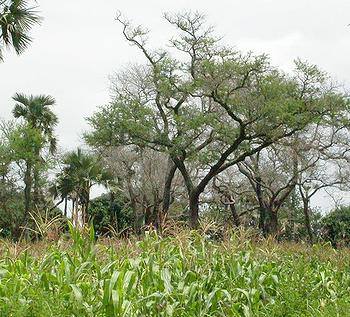 上週在奈洛比舉行的世界農林大會(World Agroforestry Congress)中專家表示,植樹不僅可以幫助非洲大陸因應氣候變遷,並且還能提供長期解決非洲大陸糧食短缺的問題。全球1,200多名專家齊聚一堂,針對在農場上植樹以尋求人類生存之道的可能性進行討論。
上週在奈洛比舉行的世界農林大會(World Agroforestry Congress)中專家表示,植樹不僅可以幫助非洲大陸因應氣候變遷,並且還能提供長期解決非洲大陸糧食短缺的問題。全球1,200多名專家齊聚一堂,針對在農場上植樹以尋求人類生存之道的可能性進行討論。
綠帶運動(Greenbelt Movement)創始人,同時也是2004年諾貝爾和平獎得主馬薩伊(Wangari Maathai)向與會代表傳達了一個緊急的信息。她特別強調以植樹來幫助非洲適應氣候變遷所帶來極端氣候的重要性。
今年5月,聯合國環境規劃署(UNEP)和世界農林中心(World Agroforestry Centre)共同發起碳補助計畫(Carbon Benefits Project)。該計劃由全球環境基金(Global Environment Facility)撥款數百萬美元,用來開發相關工具,以測量陸地上特別是地形較複雜地帶的碳儲存量。
馬薩伊表示,該計畫「可能成為百萬農民、林農和所有發展中國家的保育人員開啓數十億美元碳市場之門的關鍵。植樹儲碳以因應氣候變遷的前景大有可爲。」
有鑒于此,這次世界農林大會中有一樹種躍升成為矚目的焦點。
相思樹(Faidherbia albida)由於其高聳且長壽、氮穩定性高的特點,因此耗費的化學肥料有限;還可為牲畜提供飼料、作爲造屋和燃料的木材、把樹皮當成藥材,以及當作防風林與撒哈拉沙漠以南的非洲地區農民防範土壤侵蝕的利器。
與會的科學家表示,生長快速的相思樹證明了在農場植樹的好處,同時相思樹還能適應各種廣泛的氣候和從乾燥的沙漠到潮濕的熱帶土壤。
與其他樹木不同,相思樹在雨季初期落葉並進入休眠狀態。只有在旱季時,才會再次長出葉子來。也就是說相思樹不與糧食作物爭水、養分或光源,兩者之間儼然存在著互補的關係。
此外,當薩赫勒地帶(Sahel)大多數的植物在雨季結束無法提供蜜蜂糧食時,相思樹的花便扮演餵養蜜蜂很重要的角色。
農林中心的研究顯示,馬拉威有相思樹林蔭的地區比區外的玉米產量多了280%。
這份關於相思樹的研究結果受到肯亞官員、環保人士和農藝學家一致的歡迎,特別是在肯亞為防止飢荒持續擴大而請求緊急糧食援助的當下。在糧食短缺的推動之下,當地主食玉米的價格在過去一年來上漲了一倍。
Tree planting can help the African continent cope with climate change and also provide a long-term solution to the continent's food scarcity problems, experts told the World Agroforestry Congress last week in Nairobi. More than 1,200 global experts gathered to consider growing trees on farms for humanity's survival.
Delegates heard an urgent message from founder of the Greenbelt Movement and 2004 Nobel Peace Prize Laureate Wangari Maathai, who emphasized the importance of planting trees to help Africa adapt to the extreme weather conditions brought by climate change.
In May, the Carbon Benefits Project was launched by UNEP and the World Agroforestry Centre. Funded by the Global Environment Facility, this multi-million dollar project is developing tools for measuring terrestrial carbon storage, particularly on complex landscapes.
The project "could become the key to unlocking the multi-billion dollar carbon markets for millions of farmers, foresters and conservationists across the developing world," Maathai said. "Farming carbon to combat climate change is an exciting prospect."
One tree species emerged as the darling of the World Agroforestry Congress.
With its nitrogen-fixing qualities, the tall, long-lived acacia tree, Faidherbia albida, could limit the use of chemical fertilizers; provide fodder for livestock, wood for construction and fuel, and medicine through its bark, as well as windbreaks and erosion control to farmers across sub-Saharan Africa.
The fast-growing tree demonstrates the benefits of planting trees on farms and is adapted to a wide array of climates and soils from the deserts to the humid tropics, said the scientists at the meeting.
Unlike other trees, Faidherbia sheds its leaves and goes dormant during the early rainy season. Its leaves grow again only in the dry season, so it is compatible with food crops because it does not compete with them for water, nutrients or light.
Faidherbia albida is important for raising bees, since its flowers provide bee forage at the close of the rainy season, when most plants in the Sahel do not.
The Agroforestry Centre's research showed that in Malawi maize yields increased by 280 percent in the zone under the tree canopy compared with the zone outside the tree canopy.
The Faidherbia research was welcomed by Kenyan officials, environmentalists and agronomists at a time when Kenya is asking for emergency food aid in order to prevent widespread famine. Pushed up by shortages, the price of the maize, the staple food here, has doubled over the past year.




